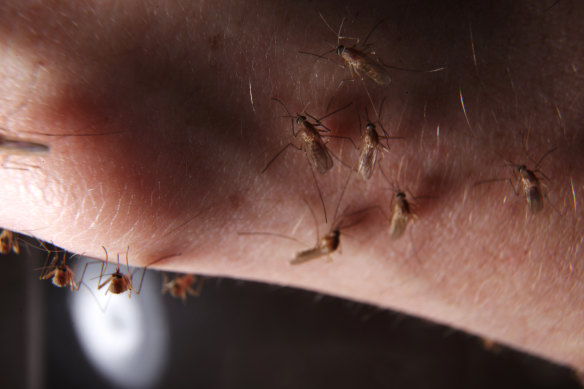
“Flooding brings lots of water to the environment and as soon as it starts to recede into stagnant pools, ponds and wetlands, that’s when the mosquitoes will really take advantage of it.”
Cameron Webb said mosquito populations across flooded areas of NSW would increase significantly.Credit:Millie Muroi
Webb said it’s not just flooded regional areas that can expect an increase in mosquito numbers, as populations also rise when warm weather accompanies more water on the ground.
“We’re going to see the most significant rises in mosquito populations across those flooded areas of inland New South Wales, but we will start to see it around the coast and particularly around Sydney, too, over the weeks and months ahead,” Webb said.
“As floodwaters recede and the weather continues to warm as we get towards summer, unfortunately, the conditions will be even better for mosquitoes.”
Those in regional areas have also been shocked by the size of the mosquitoes, which Webb said also reflected his observations.
Mosquitoes on a glass window, drawn to light at a nature retreat in the Macquarie Marshes.Credit:Nick Moir
“The mosquitoes we see in spring after flooding are typically larger, up to twice the size of the average ‘backyard mozzie’,” he said.
Storm chaser and photographer Diane Harris crossed the border from Victoria to photograph the Murray River on Sunday and said she was “eaten alive” while working.

Mosquito numbers have increased as a result of water brought by floods and warming weather.Credit:Nick Moir
“As soon as we hopped out of our car they were all over our faces,” she said. “They were on our eyes, our nose, they got into our clothes, and we had to pull them out of our hair. You looked into puddles and mosquitoes were all you saw.”
Loading
Mosquitoes can transmit diseases to humans, including Japanese encephalitis and the Ross River virus.
NSW Health has issued advice for people to minimise their risk of being bitten, which includes: reducing the amount of exposed skin; applying insect repellent and; being aware of peak risk times for mosquito bites including dawn, dusk and early evening.
The Morning Edition newsletter is our guide to the day’s most important and interesting stories, analysis and insights. Sign up here.









 Add Category
Add Category